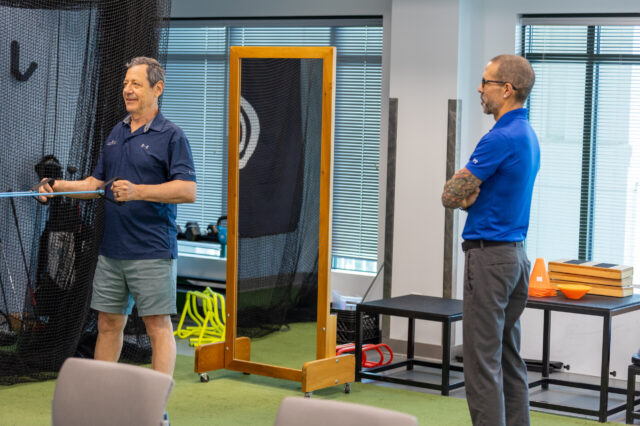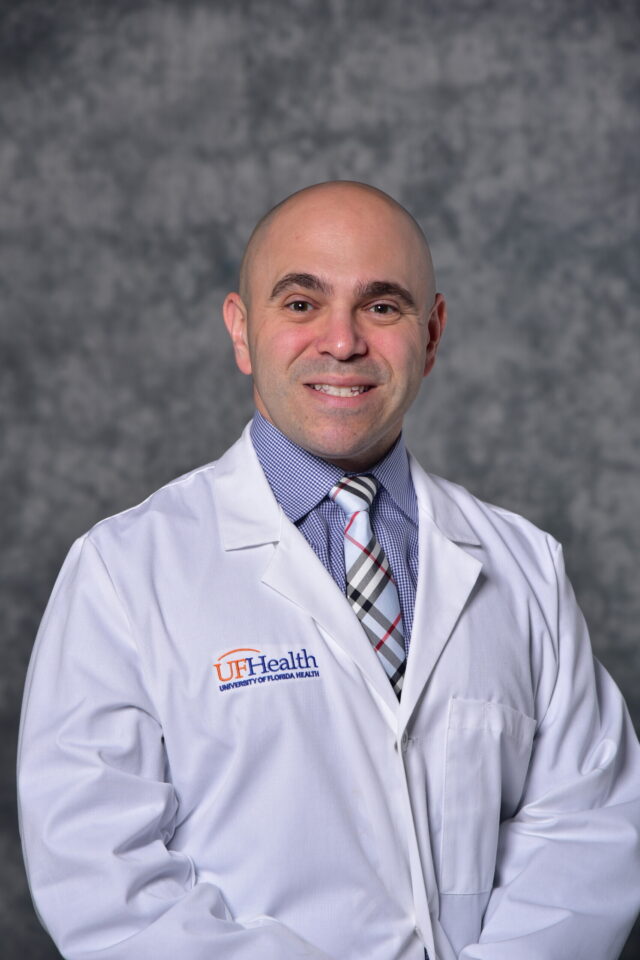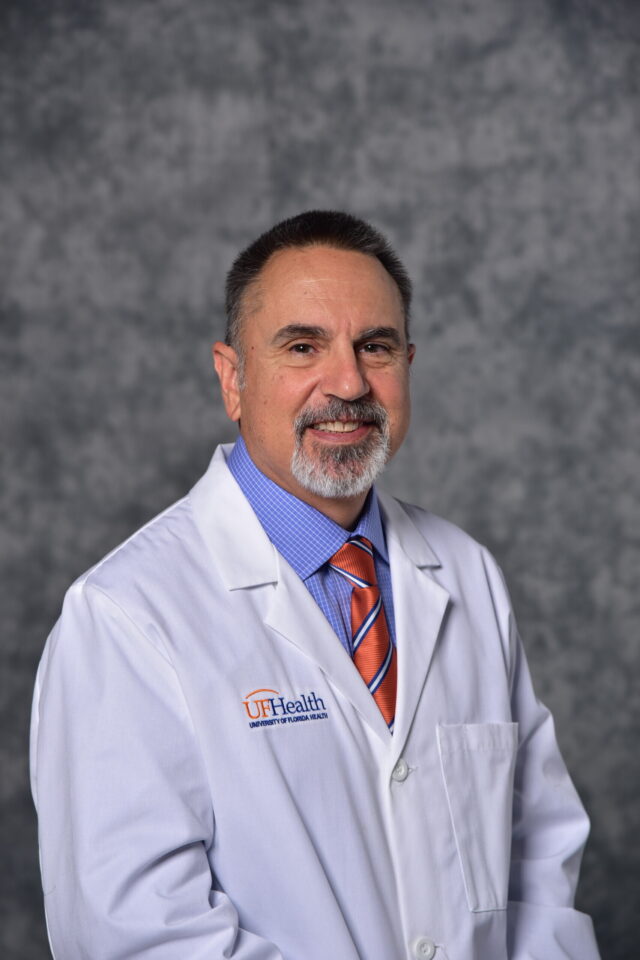Exemplary Orthopaedic Care: A Night for Heroes Spotlight
A team of orthopaedic specialists at UF Health Jacksonville provided exemplary care for the 2024 A Night for Heroes patient honoree, Harvey Doliner. They were able to save the patient’s arm after he accidentally ran into a plane propeller.

A team of orthopaedic specialists at UF Health Jacksonville provided exemplary care for the 2024 A Night for Heroes patient honoree, Harvey Doliner. They were able to save the patient’s arm after he accidentally ran into a plane propeller.
University of Florida Department of Orthopaedic Surgery and Rehabilitation – Jacksonville physicians are renowned experts in their fields, offering patients leading-edge treatments and promising recoveries.
Read more below about how two orthopaedic surgeons cared for Harvey Doliner.
Adam Gitlin, MD, orthopaedic trauma surgeon, UF Health Jacksonville
Can you tell us about what was happening with Harvey, and what course of action was taken when he got to UF Health Jacksonville?
Dr. Gitlin: When Harvey arrived, he had a real bad injury to his entire right arm, with multiple fractures and open wounds. A lot of people were really concerned about the ultimate viability of his arm. The most urgent course of action was to get him to the operating room.
When we were in the operating room, we were able to make a good assessment of Harvey’s injuries. After stabilizing him and taking care of the most urgent matters appropriately, we decided to try and save his arm.
After getting him stabilized, what was the next course of action?
Dr. Gitlin: I was called in, working with the trauma team and the general surgery trauma surgeons for the orthopaedic injuries. This included the multiple fractures to his arm, the soft tissue injury, the tendon injuries and the multiple lacerations.
Once we evaluated Harvey, we saw that he was still able to move his fingers, and he still had full sensation. We cleaned out his arm of any debris, closed up all of his lacerations, and stabilized him with external fixation to keep the bones in a good proper position.
With an intense injury like Harvey’s, how many surgeries did he have, and what was his rehab like afterwards?
Dr. Gitlin: Harvey required multiple surgeries. In addition to the emergency surgery he had when he first came in, we had gone back to the operating room at least three or four times to take care of his arm. From there, we were able to stabilize and fix all of his fractures, remove the external fixator that was keeping his arm in a good healthy position, and take care of the multiple muscle and tendon injuries.
We also were making sure to minimize the risk for infection and to stabilize him, so that we could start working on his rehab almost immediately after surgery. One of the benefits of fixing his arm and stabilizing and repairing all the tendon injuries was to minimize as much scarring as possible and to allow Harvey to start working on his range of motion and his muscle strengthening within a short time after surgery.
Talk about the process of evaluating him throughout the months after his surgeries.
Dr. Gitlin: Harvey has been a wonderful patient to work with. He is very diligent and sticks to his rehab plan very closely, and attends all of his therapy sessions. We're in constant communication with his physical therapists and his occupational therapists to ensure that he's making proper progress and achieving all of his milestones that's appropriate for his injury.
One of the good things here at UF Health Jacksonville is that anytime when there may be an issue, we're able to communicate with our therapists and our own specialists within our trauma team to see what further care Harvey may need, or what else we can do to try to get him back as fully functional.
Tell us about the collaboration between multiple departments and specialties, to make sure that Harvey was well taken care of when he presented to the hospital.
Dr. Gitlin: We were always in constant communication with the entire trauma team here, with trauma surgery, with rehab, and with our operating team. We knew the most important thing was to get Harvey out of danger and to stabilize his injuries.
We were able to get him to the operating room very quickly and to start working on him immediately. Afterwards, we knew that an injury like this was going to have a prolonged recovery time. We were able to start his rehab almost immediately, since we were working directly with inpatient physical and occupational therapy.
Harvey has been adamant about saying he is willing to travel back here from his hometown in New Jersey, to finish off his care and rehabilitation. What does that say about the care someone can get here at UF Health Jacksonville?
Dr. Gitlin: I'm proud of the care that we are able to provide here – from our trauma team, our orthopaedic surgery team, our hand surgery team, and our rehab team. For Harvey to travel back and forth between Florida and New Jersey, it really says a lot about how we're able to care for people.
Marc Kaye, MD, orthopaedic hand and upper extremity surgeon, UF Health Jacksonville
Walk us through the severity of Harvey’s condition when you first evaluated him.
Dr. Kaye: Harvey had sustained both a severe crush and soft tissue avulsion type of injuries. Both bones in his forearm and several in his hand were shattered, as well as fracture of his shoulder. He had lost all the soft tissue covering the back of his forearm. He was at great risk of losing his arm below the elbow.
What was the medical strategy and treatment so that he could keep his arm?
Dr. Kaye: Our first strategy was to stabilize Harvey, that is, to save life over limb. The next step was to try and determine if his limb was salvageable. In Harvey’s case, we felt that we would be able to save and reconstruct the limb to give him a functional arm and hand.
How long does it take someone in Harvey’s condition to recover?
Dr. Kaye: His type of injury usually takes about a year and a half to recover to a great degree with some additional recovery. Harvey is super motivated and takes every little improvement as a victory. He is in it for the long haul, as he understands the recovery process is a marathon and not a sprint.
In your expert opinion, how confident are you that Harvey will be able to get back to the things he loves, like flying and playing tennis?
Dr. Kaye: He has already returned to flying, under the supervision of a copilot. He routinely goes to the gym and works out with weights and exercise machines, meaning, he is able to grip and lift/carry weight with his injured hand.
Talk about the multidisciplinary approach to treat Harvey.
Dr. Kaye: Given all the reconstruction Harvey had to his arm and hand, as well as his shoulder fracture repair, he required intensive hand and upper extremity therapy of specialized hand/occupational therapy and physical therapy, including some wound care. The different teams stayed in constant communication, coordinating care and adjusting when needed.
Putting in the multidisciplinary intensive effort and care, with compassion and empathy, is what we do every day for all our patients. It is who we are as individuals and medical providers. We are very fortunate to have such a team at UF Health Jacksonville.
About the author


